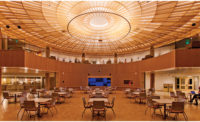Aurillac, France
Located in the heart of France’s Cantal region, the small city of Aurillac is the stuff of postcards, its surrounding landscape featuring the smoothed peaks of the extinct Massif Central volcanoes. Although this sleepy town is a six-hour, southward drive from Paris, it entertains a cosmopolitan point of view. It hosts an annual street theater festival that champions the Theater of the Absurd tradition, as well as a 155-year-old museum devoted to local art and natural history. A new multipurpose hall, designed by London-based Brisac Gonzalez Architects, riffs on Aurillac’s geological heritage as well as its highbrow predilections.
The site of the hall, which serves as a venue for concerts, trade fairs, sporting events, and theater, was neither topographically nor culturally memorable prior to this building. When Brisac Gonzalez entered the Aurillac municipality’s competition for the project in 2003, the site was used as a parking lot and occasional fairground adjacent to the city train station. “Though technically called the Plaza of the 8th of May, commemorating the end of World War II in Europe… it was in essence a vast residual space,” says Edgar Gonzalez, who founded his architecture firm with Cécile Brisac in 1999 after winning an international competition for the Museum of World Culture in Gothenburg, Sweden.
The Brisac Gonzalez design, which was realized in December, comprises three volumes that Gonzalez refers to as ribbons, and which total approximately 56,700 square feet. Although these forms do not echo the mountainscape literally, they evoke the tectonics that produced Massif Central. In plan, the entryway is reminiscent of a plume, emerging from the building base and fanning outward; the base itself is rectilinear, and contains the auditorium as well as storage and back-of-house spaces like the loading dock. Above this pairing sits the third volume, representing the double-height volume of the 4,500-seat auditorium. This form bows slightly inward on its sides, and the architects shifted it from center, creating a slight tension by cantilevering it from the plinth asymmetrically.
“I would say that we like to challenge accepted building typologies,” Gonzalez says of his studio’s growing portfolio of work. That is also the case with Aurillac, he explains. “It is often the case that these types of buildings are characterized by a single expressive gesture usually legible from afar. Yet closer, these buildings reveal little else—they often lack articulation. We wanted the building to read at different scales. The ribbons articulate the building’s ‘natural heroic scale’ from afar, while the shape and textures of the ribbons give the building a different reading at close range.”
To achieve texture, the top layer of the Aurillac multipurpose hall includes 25,000 pyramidal glass bricks studding its precast-concrete skin—the most notable decorative touch on this otherwise reserved building. “We wanted an animated facade during the day, and since Aurillac has a large number of sunny days, we thought that a three-dimensional shape would shimmer and play with the sun’s rays,” Gonzalez says. “The curvature of the facades along with the pyramid-shaped glass bricks creates a variety of interesting shadows.”
At night, the bricks refract LEDs that backlight them from the top and bottom of the facade. The building operator can reprogram this surface’s 24 circuits to switch between one or eight colors, and continually delight residents. They may also transform the multipurpose hall into an abstract billboard, with lighting chosen to complement whatever program this versatile building may be hosting that night. Although the multipurpose hall is like a mountain in a postcard, easy to take in from a distance, these broad strokes of color and movement invite the curious tourist to switch from hiking gear to evening wear, exploring the architectural details closer up as well as the performances being staged inside.



Post a comment to this article
Report Abusive Comment